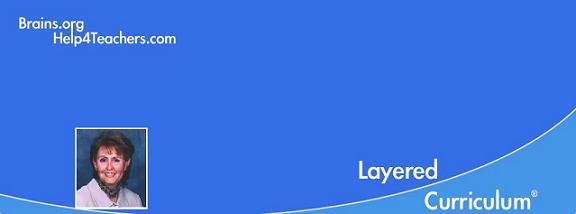__________Layered Curriculum®. . . because every child deserves a special education™_
 |
|
![]() _
_ ![]()
Layered
Curriculum TEXT & WORKBOOK
Set
for only
$43.95
(free shipping in
US)
Tweet
If the Thought of Flipping Your Classroom Makes You Dizzy,
Tip It Sideways InsteadBy Dr. Kathie F. Nunley
© 2016Several years ago, educators and education media were enthusiastically talking about Flipped Classrooms. A flipped or "inverted" classroom is one in which a teacher takes what was a traditional classroom of the the last century - one where we all lectured to students during classtime and then expected that homework was completed outside of classrime - and flip the whole thing.
The idea behind it makes sense, given the technology that became available over the past 20 years. In fact teachers felt pressure from students, parents and the community to utilize technology in order to make better use of school time. So, the theory was that In a flipped classroom, lectures could be recorded and uploaded online. Students would watch these as homework at home outside the school day. Then the actual class time would be spent on interaction between students and teachers, doing question and answers and assignment drills.
However, while the flipped classroom was discussed in the media, online PD sessions and trade books, the reality was that out in the trenches, we were not seeing this happening much. So while many of us could appreciate the vision and understand the possibility, the reality was that the thought of flipping our classroom was logistically quite overwhelming.
There are several reasons that this vision could not translate well into reality.
One big objection to the flipped classroom is that having every student watch a taped lecture at night for class discussion the next day is one giant step backwards in differentiating for the needs of our diverse learners.
Another reality -- Sure, the latest whizmo gadget and fantastic technological device may excite and tempt us with their novelty and WOW-factor, but when push comes to shove and work needs to be done, often times we find that we are more effective and efficient with some of our tried-and true-standards.
So, what's a teacher to do?
I propose that rather than flipping your classroom completely on its head (which, let's face it, gives us the same lesson, just upside down), we instead tip it sideways a bit and let things flow broadly from side to side.
For years, I've been telling teachers that one of the greatest ways to make better use of your time in the classroom has been to record your lectures and lessons. But we need to use these taped or uploaded lessons, not for homework, but as one of the classroom day assignment options.
Most of us understand, that in this day of technology, a live straight-out lecture to a room full of students attempting to listen, is a definite waste of our valuable time, and not doing too much for many of the students either.
When Layered Curriculum® first began, technology in schools and our communities was not at a point that allowed for taped or online lessons, so many teachers tried to do mini lectures to small groups as an optional assignment in class. This was met with limited success. Anyone who has tried to oversee 20 - 35 learners in one room knows the logistic problems that come with that. Now that mediated lessons are easy to make and equipment readily available in most schools - problem solved.
But these mediated lessons should not be relegated and mandated as homework for all. This ignores too many of our students who have different learning modalities, presents problems for students without access to technology outside of school, and creates too much distance between receiving the lesson and student questions and feedback.
The Layered Curriculum® classroom lends itself beautifully to taped or mediated lectures and lessons. They are included as assignment options, usually in the C layer. Any and all students who might benefit from listening to a lecture or watching a demonstration, can make use of the opportunity. Teacher class time is freed up to work with students individually. Students are near a teacher during and directly after a lecture for questions and clarification. Students can catch the lesson missed from a day of absence, or just watch it more than once for relearning opportunity or study. And best of all, the classroom learning environment remains open and accessible to a wide variety of learners.
For more detailed information, read the text "Layered Curriculum" or the new supplement "Enhancing your Layered Curriculum Classroom".
About the Author:
Dr Kathie Nunley is an educational psychologist, researcher and author of several books on parenting and teaching, including A Student's Brain (Brains.org) and the best selling, "Differentiating the High School Classroom" (Corwin Press). She is the developer of the Layered Curriculum® method of instruction and has worked with parents and educators around the world to better structure schools to make brain-friendly environments. In addition, her work has been used by the Boeing Corporation, Family Circle Magazine, the Washington Post, and ABC television.
Email her: Kathie (at) brains.orgCopyright © 1998 - current year by Kathie F. Nunley.
All Rights Reserved.
Layered
Curriculum is a registered trademark developed by
Dr. Kathie F. Nunley.